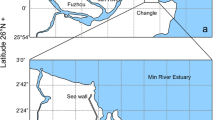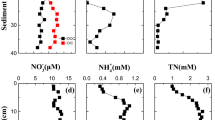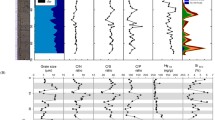Abstract
The potential for microscale bacterial Fe redox cycling was investigated in microcosms containing ferrihydrite-coated sand and a coculture of a lithotrophic Fe(II)-oxidizing bacterium (strain TW2) and a dissimilatory Fe(III)-reducing bacterium (Shewanella alga strain BrY). The Fe(II)-oxidizing organism was isolated from freshwater wetland surface sediments which are characterized by steep gradients of dissolved O2 and high concentrations of dissolved and solid-phase Fe(II) within mm of the sediment–water interface, and which support comparable numbers (105–106 mL−1) of culturable Fe(II)-oxidizing and Fe(III)-reducing reducing. The coculture systems showed minimal Fe(III) oxide accumulation at the sand-water interface, despite intensive O2 input from the atmosphere and measurable dissolved O2 to a depth of 2 mm below the sand–water interface. In contrast, a distinct layer of oxide precipitates formed in systems containing Fe(III)-reducing bacteria alone. Examination of materials from the cocultures by fluorescence in situ hybridization indicated close physical juxtapositioning of Fe(II)-oxidizing and Fe(III)-reducing bacteria in the upper few mm of sand. Our results indicate that Fe(II)-oxidizing bacteria have the potential to enhance the coupling of Fe(II) oxidation and Fe(III) reduction at redox interfaces, thereby promoting rapid microscale cycling of Fe.
Similar content being viewed by others
References
Armstrong W (1964) Oxygen diffusion from the roots of some British bog plants. Nature 204: 801–802.
Arnold RG, Hoffmann MR, DiChristina TJ & Picardal FW (1990) Regulation of dissimilatory Fe(III) reduction activity in Shewanella putrefaciens. Appl. Environ. Microbiol. 56: 2811–2817.
Benz M, Brune A & Schink B (1998) Anaerobic and aerobic oxidation of ferrous iron at neutral pH by chemoheterotrophic nitrate-reducing bacteria. Arch. Microbiol. 169: 159–165.
Brendel PJ & Luther GW (1995) Development of a gold amalgam voltammetric microelectrode for the determination of dissolved Fe, Mn, O-2, and S(-II) in porewaters of marine and freshwater sediments. Environ. Sci. Technol. 29: 751–761.
Brock TD & Gustafson J (1972) Sulfolobus: a new genus of sulfur-oxidizing bacteria living at low pH and high temperature. Arch. Microbiol. 84: 54–68.
Caccavo F, Blakemore RP & Lovley DR (1992) A hydrogen-oxidizing, Fe(III)-reducing microorganism from the Great Bay estuary, New Hampshire. Appl. Environ. Microbiol. 58: 3211–3216.
Cornell RM & Schwertmann U (1996) The Iron Oxides. VCH, New York.
Davison W (1993) Iron and manganese in lakes. Earth-Sci. Rev. 34: 119–163.
Davison W & Seed G (1983) The kinetics of the oxidation of ferrous iron in synthetic and natural waters. Geochim. Cosmochim. Acta 47: 67–79.
Davison W, Grime GW, Morgan JAW & Clarke K (1991) Distribution of dissolved iron in sediment pore waters at submillimetre resolution. Nature 353: 323–325.
DiChristina TJ & Delong EF (1993) Design and application of rRNA-targeted oligonucleotide probes for the dissimilatory iron-and manganese-reducing bacterium Shewanella putrefaciens. Appl. Environ. Microbiol. 59: 4152–4160.
Ehrenreich A & Widdel F (1994) Anaerobic oxidation of ferrous iron by purple bacteria, a new type of phototrophic metabolism. Appl. Environ. Microbiol. 60: 4517–4526.
Ehrlich HL (1995) Geomicrobiology. Marcel Dekker, Inc., New York.
Emerson D (2000) Microbial oxidation of Fe(II) and Mn(II) at circumneutral pH. In: Lovley DR (Ed) Environmental Metal-Microbe Interactions (pp 31–52). ASM Press, Washington, DC.
Emerson D (2002) Bacterial iron oxidation at circumneutral pH. In: Coates JD & Zhang C (Eds) Iron in the Natural Environment: Biogeochemistry, Microbial Diversity, and Bioremediation (pp submitted for publication). Kluwer.
Emerson D & Revsbech NP (1994) Investigation of an iron-oxidizing microbial mat community located near Aarhus, Denmark: Field studies. Appl Environ Microbiol 60: 4022–4031.
Emerson D & Moyer C (1997) Isolation and characterization of novel lithotrophic iron-oxidizing bacteria that grow at circumneutral pH. Appl. Environ. Microbiol. 63: 4784–4792.
Emerson D, Weiss JV & Megonigal JP (1999) Iron-oxidizing bacteria are associated with ferric hydroxide precipitates (Fe-plaque) on the roots of wetland plants. Appl. Environ. Microbiol. 65: 2758–2761.
Fredrickson JK, Zachara JM, Kennedy DW, Dong H, Onstott TC, Hinman NW & Li S (1998) Biogenic iron mineralization accompanying the dissimilatory reduction of hydrous ferric oxide by a groundwater bacterium. Geochim. Cosmochim. Acta 62: 3239–3257.
Ghiorse WC (1984) Biology of iron-and manganese-depositing bacteria. Annu. Rev. Microbiol. 38: 515–550.
Glud RN, Forster S & Huettel M (1996) Influence of radial pressure gradients on solute exchange in stirred benthic chambers. Marine Ecol. Prog. Ser. 141: 303–311.
Huettel M, Ziebis W, Forster S & Luther GW (1998) Advective transport affecting metal and nutrient distributions and interfacial.597 fluxes in permeable sediments. Geochim. Cosmochim. Acta 62: 613–631.
Hunter KS, Wang Y & VanCappellen P (1998) Kinetic modeling of microbially-driven redox chemistry of subsurface environments: coupling transport, microbial metabolism and geochemistry. J. Hydrol. 209: 53–80.
Jahnke R (1985) A model for microenvironments in deep-sea sediments, formation and effects on porewater profiles. Limnol. Oceanogr. 30: 956–965.
Johnson DB, McGinness S & Ghauri MA (1993) Biogeochemical cycling of iron and sulfur in leaching environments. FEMS Microbiol. Rev. 11: 63–70.
Jorgensen BB (1977) Bacterial sulfate reduction within reduced microniches of oxidized marine sediments. Mar. Biol. 41: 7–17.
Jorgensen BB (1989) Biogeochemistry of chemoautotrophic bacteria. In: Schlegel HG & Bowien B (Eds) Biochemistry of Autotrophic Bacteria (pp 117–146) Science Tech Publishers, Madison, WI.
Jorgensen BB & Revsbech NP (1983) Colorless sulfur bacteria, Beggiatoa spp. and Thiovulum spp., in O2 and H2S microgradients. Appl. Environ. Microbiol. 45: 1261–1270.
Kusel K & Dorsch T (2000) Effect of supplemental electron donors on the microbial reduction of Fe(III), sulfate, and CO2 in coal mining-impacted freshwater lake sediments. Microb. Ecol. 40: 238–249.
Kusel K, Dorsch T, Acker G & Stackebrandt E (1999) Microbial reduction of Fe(III) in acidic sediments: isolation of Acidiphilium cryptum JF-5 capable of coupling the reduction of Fe(III) to the oxidation of glucose. Appl. Environ. Microbiol. 65: 3633–3640.
Lovley DR (1991) Dissimilatory Fe(III) and Mn(IV) reduction. Microbiol. Rev. 55: 259-287. Lovley DR (2000) Fe(III) and Mn(IV) reduction. In: Lovley DR (Ed) Environmental Metal-Microbe Interactions (pp 3-30). ASM Press, Washington, DC.
Lovley DR (2002) Fe(III)-and Mn(IV)-reducing prokaryotes. In: SFM Dworkin, Rosenberg E, Schleifer KH, & Stackebrandt E (Ed) The Prokaryotes (pp in press). Springer-Verlag, New York.
Lovley DR & Phillips EJP (1986) Organic matter mineralization with reduction of ferric iron in anaerobic sediments. Appl. Environ. Microbiol. 51: 683–689.
Lovley DR & Anderson RT (2000) The influence of dissimilatory metal reduction on the fate of organic and metal contaminants in the subsurface. J. Hydrol. 8: 77–88.
Luther GW, Brendel PJ, Lewis BL, Sundby B, Lefrancois L, Silverberg N & Nuzzio D (1998) Simultaneous measurement of O2, Mn, Fe, I-, and S(-II) in marine pore waters with a solid-state voltammetric microelectrode. Limnol. Oceanogr. 43: 325–333.
Millero FJ, Sotolongo S & Izaguirre M (1987) The oxidation kinetics of Fe(II) in seawater. Geochim. Cosmochim. Acta 51: 793–801.
Nelson DC, Jorgensen BB & Revsbech NP (1986) Growth pattern and yield of a chemoautotrophic Beggiatoa sp. in oxygen-sulfide microgradients. Appl. Environ. Microbiol. 52: 225–233.
Nevin K & Lovley DR (2002) Mechanisms of Fe(III) oxide reduction in sedimentary environments. Geomicrobiol. J. 19: 141–159.
Peine A, Tritschler A, Kusel K & Peiffer S (2000) Electron flow in an iron-rich acidic sediment - evidence for an acidity-driven iron cycle. Limnol. Oceanogr. 45: 1077–1087.
Perfil'ev BV & Gabe DR (1969) The capillary method of studying the microflora of bottom deposits, soils and subterranean waters in microbial landscapes. Capillary Methods of Investigating Micro-Organisms (pp 13–78). University of Toronto Press, Toronto.
Ratering S & Schnell S (2000) Localization of iron-reducing activity in paddy soil by profile studies. Biogeochemistry 48: 341–365.
Revsbech NP (1989) An oxygen microelectrode with guard cathode. Limnol. Oceanogr. 34: 472–476.
Roden EE & Wetzel RG (1996) Organic carbon oxidation and suppression of methane production by microbial Fe(III) oxide reduction in vegetated and unvegetated freshwater wetland sediments. Limnol. Oceanogr. 41: 1733–1748.
Roden EE, Sobolev D & Luther GW (2002) New insights into the biogeochemical cycling of iron in sedimentary environments: potential for a rapid microscale bacterial Fe redox cycle at the aerobic-anaerobic interface. In: Coates JD (Ed) Biogeochemical Cycling of Iron in Natural Environments (pp Submitted for publication) Kluwer.
Shuttleworth SM, Davison W & Hamilton-Taylor J (1999) Two-dimensional and fine structure in the concentration of iron and manganese in sediment pore-waters. Environ. Sci. Technol. 33: 4169–4175.
Singer PC & Stumm W (1972) Acid mine drainage - the rate limiting step. Science 167: 1121–1123.
Sobolev D & Roden EE (2001) Suboxic deposition of ferric iron by bacteria in opposing gradients of Fe(II) and oxygen at circumneutral pH. Appl. Environ. Microbiol. 67: 1328–1334.
Sobolev D, Emerson D & Roden E (2002) Characterization of a chemolithoautotrophic Fe(II)-oxidizing bacterium from the ß-subclass of the Proteobacteria isolated from freshwater wetland sediments. Manuscript in preparation.
Straub KL & Buchholz-Cleven BEE (1998) Enumeration and detection of anaerobic ferrous-iron oxidizing, nitrate-reducing bacteria from diverse European sediments. Appl. Environ. Microbiol. 64: 4846–4856.
Straub KL, Benz M, Schink B & Widdel F (1996) Anaerobic, nitrate-dependent microbial oxidation of ferrous iron. Appl. Environ. Microbiol. 62: 1458–1460.
Stumm W & Sulzberger B (1992) The cycling of iron in natural environments: Considerations based on laboratory studies of heterogeneous redox processes. Geochim. Cosmochim. Acta 56: 3233–3257.
Taillefert M, Bono A & Luther G (2000) Reactivity of freshly formed Fe(III) in synthetic solutions and (pore)waters: voltammetric evidence of an aging process. Environ. Sci. Technol. 34: 2169–2177.
Thamdrup B (2000) Bacterial manganese and iron reduction in aquatic sediments. Adv. Microb. Ecol. 16: 41–84.
Thamdrup B, Fossing H & Jorgensen BB (1994) Manganese, iron, and sulfur cycling in a coastal marine sediment, Aarhus Bay, Denmark. Geochim. Cosmochim. Acta 58: 5115–5129.
vandenEnde FP, Meier J & vanGermerden H (1997) Syntrophic growth of sulfate-reducing bacteria and colorless sulfur bacteria during oxygen limitation. FEMS Microbiol. Ecol. 23: 65–80.
Weber KA, Picardal FW & Roden EE (2001) Microbially-catalyzed nitrate-dependent oxidation of biogenic solid-phase Fe(II) compounds. Environ. Sci. Technol. 35: 1644–1650.
Westermann P (1993) Wetland and swamp microbiology. In: Ford TE (Ed) Aquatic Microbiology: An Ecological Approach (pp 295–302). Blackwell Scientific, Boston.
Widdel F, Schnell S, Heising S, Ehrenreich A, Assmus B & Schink B (1993) Ferrous iron oxidation by anoxygenic phototrophic bacteria. Nature 362: 834–835.
Woomer PL (1994) Most probable number counts. In: Bigham JM (Ed) Methods of soil analysis Part 2 - Microbiological and Biochemical Properties (pp 59–79). Soil Science Society of America, Madison.
Author information
Authors and Affiliations
Corresponding author
Rights and permissions
About this article
Cite this article
Sobolev, D., Roden, E.E. Evidence for rapid microscale bacterial redox cycling of iron in circumneutral environments. Antonie Van Leeuwenhoek 81, 587–597 (2002). https://doi.org/10.1023/A:1020569908536
Issue Date:
DOI: https://doi.org/10.1023/A:1020569908536




